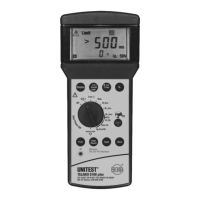If the resistance measured exceeds 1999 Ω,
the attention symbol (1) and '>1999 Ω' are di-
splayed on the screen. As there is no valid me-
asurement value for RI, it is not possible to cal-
culate and display the short-circuit current IK.
'---' is displayed in the small result field (14).
The short-circuit current is calculated using the
mains voltage and the loop impedance. Here,
the value 230V/400V is used for the mains vol-
tage if it amounts close to 230V / 400V. If the
measurement value deviates considerably
from 230V / 400V, the actual measurement
value is used to calculate the short-circuit cur-
rent.
Supply system preloading and voltage fluctu-
ations can lead to erroneous measurement re-
sults. Therefore, you are advised to perform
several measurements and to compare the me-
asurement results.
If many measurements are performed allowing
only "short breaks", the internal over tempera-
ture protection of the Telaris 0100 plus is trig-
gered and the symbol for excessive tempera-
ture (20) is displayed on the screen. The
following mains internal resistance measure-
ment may only be started once the instrument
has cooled down and the symbol (20) has di-
sappeared from the screen. Thus, any damage
to the instrument can be avoided.
You may store the measurement result by pres-
sing the 'Store' key (27).
If you wish to store the condition of a faulty
socket, please press the "Start” key (26) first.
After hearing the "Error Signal” you may press
the "Store” key (27).
Measurements within the three-phase sy-
stem: when measuring the internal resistance
within a three-phase system, you must con-
nect L1 (33) and L2 (34) to the phases to be te-
sted. You may not connect L3 (35). The socke
test does not make sense for the internal resi-
stance measurement between two phases.
Therefore, the contact electrode (25) should
not be touched. When touching the contact
electrode, a PE error is indicated.
17
Mains Internal Resistance Measurement / Short Circuit Current Measurement

